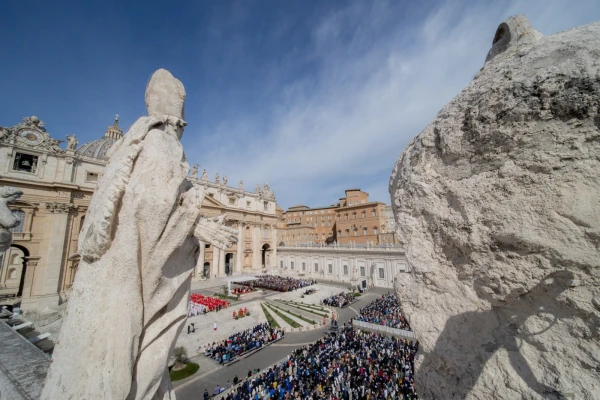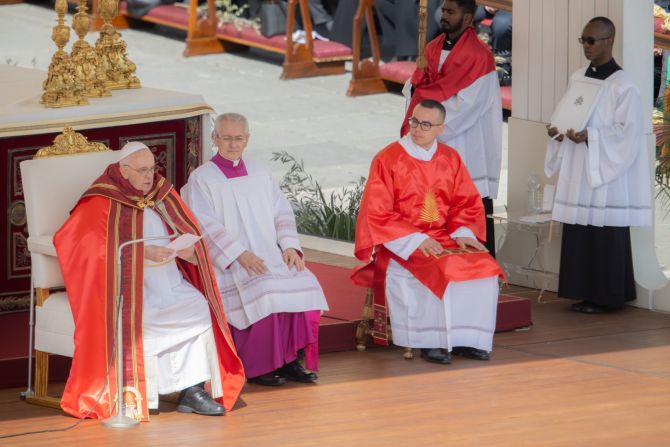Pope Francis presided over Palm Sunday Mass in St. Peter’s Square on April 2, 2023. | Daniel Ibanez/CNA
On Palm Sunday, Pope Francis said Jesus voluntarily took on the pain and abandonment of his Passion and Crucifixion so that he could be with us in whatever sorrow or difficulty we might be experiencing.
Jesus “experienced abandonment in order not to leave us prey to despair, in order to stay at our side forever,” the pope said during Palm Sunday Mass in St. Peter’s Square April 2.
“He did this for me, for you,” he said, “because whenever you or I or anyone else seems pinned to the wall — and we have seen someone pinned to the wall — you see someone lost in a blind alley, plunged into the abyss of abandonment, sucked into a whirlwind of ‘whys’ without answer, there can still be some hope…”

Pope Francis presided over the Palm Sunday Mass one day after being discharged from Rome’s Gemelli Hospital.
The pope was admitted to the hospital for three days beginning March 29 for treatment for a bronchitis infection, the Vatican said.
An estimated 60,000 people were at the papal Mass, according to the Vatican Gendarmes.
In his homily, Francis spoke in a soft voice as he emphasized that whatever situation of abandonment we find ourselves in, Jesus is at our side.
The pope also said that we would find Jesus in those who are abandoned, recalling the death in November last year of a homeless man from Germany who was found under the colonnade of St. Peter‘s Square.

Jesus “wants us to care for our brothers and sisters who resemble him most, those experiencing extreme suffering and solitude,” he said. “Today, brothers and sisters, there are entire peoples who are exploited and abandoned; the poor live on our streets, and we look the other way, we turn around; there are migrants who are no longer faces but numbers; prisoners are disowned; people written off as problems.”
Pope Francis said these people are “Christs” for us: “People who are abandoned, invisible, hidden, discarded with white gloves,” such as the unborn, the isolated elderly, the forgotten sick, the abandoned disabled, and the lonely young.
Pope Francis entered St. Peter’s Square in the popemobile April 2. He was driven to the central obelisk for the blessing of the palms and the proclamation of a reading from the Gospel of St. Matthew and the singing of Psalm 23.

The blessing followed the procession of cardinals, bishops, priests, deacons, and laypeople carrying palm fronds, olive branches, and the large weaved palms called “parmureli” to commemorate Jesus’ entrance into Jerusalem. Pope Francis has not led the procession since 2019.
For the start of Mass, the pope was again driven in the popemobile from the obelisk to the altar in front of St. Peter’s Basilica.
Palm Sunday, also called Passion Sunday, marks the beginning of Holy Week, which will lead into the sacred Triduum of Holy Thursday, Good Friday, and Holy Saturday, and concludes with the celebration of Christ’s Resurrection beginning at the Easter Vigil.
On Palm Sunday, the Mass includes the reading of the Lord’s Passion from the Gospel of St. Matthew.
In his homily on April 2, Pope Francis focused on a line from the Gospel and repeated in the Psalm — Jesus’ cry of abandonment to the Father — “My God, my God, why have you forsaken me?”
“‘My God, my God, why have you forsaken me?’ In the Bible, the word ‘forsake’ is powerful,” the pope said.

He noted how one might feel forsaken “at moments of extreme pain: love that fails or is rejected or betrayed; children who are rejected and aborted; situations of repudiation, the lot of widows and orphans; broken marriages, forms of social exclusion, injustice and oppression; the solitude of sickness.”
“In a word, in the drastic severing of the bonds that unite us to others,” he said. “There [Jesus] tells us this word: abandonment. Christ brought all of this to the cross; upon his shoulders, he bore the sins of the world. And at the supreme moment, Jesus, the only begotten, beloved Son of the Father, experienced a situation utterly alien to his very being: the abandonment, the distance of God.”
“Jesus, in his abandonment, asks us to open our eyes and hearts to all who find themselves abandoned,” he said.
“But, why did it have to come to this? For us. There is no other answer: us,” Francis underlined. “He became one of us to the very end in order to be completely and definitively one with us.”
At the end of his homily, Pope Francis remained in silence for over two and a half minutes before the singing of the Creed.
Jesus, the pope said, “has endured the distance of abandonment in order to take up into his love every possible distance that we can feel. So that each of us might say: in my failings — each of you has fallen many times — and I can say in my failings, in my desolation, whenever I feel betrayed, or I have betrayed someone, when I feel cast aside or I have cast aside others, or when I feel forsaken or have forsaken others, we can think that Jesus was abandoned, betrayed, cast aside.”

In our failures, we can remember that Jesus is at our side, Pope Francis said. “When I feel lost and confused when I feel that I can’t go on, he is with me, and he is there. In the thousand fits of ‘why…?’ and with many ‘whys’ unanswered, he is there.”
At the conclusion of Mass, Pope Francis led the Angelus, a traditional prayer honouring Mary.
In a brief message before the prayer, he invited Catholics to live Holy Week “as the tradition of God’s holy faithful people teaches us, that is, accompanying the Lord Jesus with faith and love.”
“Let us learn from our Mother, the Virgin Mary,” he said. “She followed her Son with the closeness of her heart; she was one soul with him and, although she did not understand everything, together with him she surrendered herself fully to the will of God the Father.”
“May Our Lady help us to be close to Jesus present in the suffering, discarded, abandoned people. May Our Lady take us by the hand to Jesus present in these people,” he said. “To all, happy journey toward Easter.”
From the popemobile, Pope Francis greeted those gathered in the square and in the adjoining thoroughfare after the Mass.
The full text of Pope Francis’ homily for Palm Sunday 2023 can be read here.
Source: CNA

